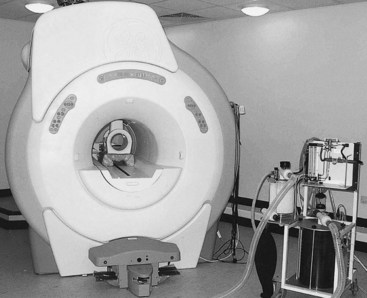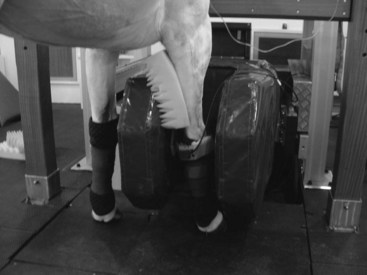Chapter 21 Magnetic Resonance Imaging
Magnetic resonance imaging (MRI) is a method of imaging that can allow examination of both osseous and soft tissues with detailed anatomical resolution and also provides some physiological information. Advances in technology during the past 10 years have made it possible for MRI to become a practical diagnostic tool in both anesthetized and standing horses (Figures 21-1 and 21-2).1 Use of MRI has revolutionized our understanding of foot pain in the horse and has considerably improved understanding of other types of lameness further proximally in the limb.2-5 As a result, MRI is increasingly being used for diagnosis of orthopedic disorders in equine practice and can add considerable information to a diagnostic investigation. However, as with any imaging technique, MRI is only useful in the context of the entire clinical picture and needs to be interpreted in light of other diagnostic findings. Terminology is sometimes confused: magnetic resonance (MR) refers to the absorption of energy exhibited by particles (as atomic nuclei or electrons) in a static magnetic field when the particles are exposed to electromagnetic radiation of certain frequencies. MRI refers to a noninvasive diagnostic technique that produces computerized images of internal body tissues and is based on nuclear magnetic resonance of atoms within the body induced by the application of radio waves.
Equipment for MRI in Horses
MRI can be performed in horses using various different types of systems. High-field closed systems are similar to those used in many human hospitals. These units have a superconducting, helium-cooled magnet in a cylindrical configuration into which the area of interest of the horse has to be squeezed; thus the horse needs to be under general anesthesia, and a team of operators is required to position the horse (see Figure 21-1). There are low-field open MRI systems that also require horses to be imaged under general anesthesia but have fewer restrictions on space; therefore it may be easier to position the horse into the imaging portion of the magnet. A low-field MR system for the standing horse has been developed specifically for the equine market, which has allowed images to be acquired with horses under sedation (see Figure 21-2). Use of motion-insensitive imaging sequences helps to account for slight sway that may occur during sedation. Time for image acquisition is generally longer in low-field units for the same or less resolution and image quality as a high-field system; thus horses may require sedation or general anesthesia for more prolonged periods to acquire images of the entire region required.





